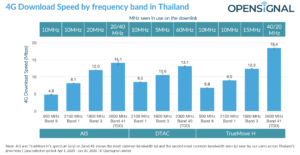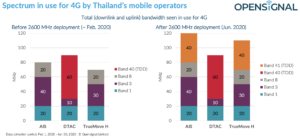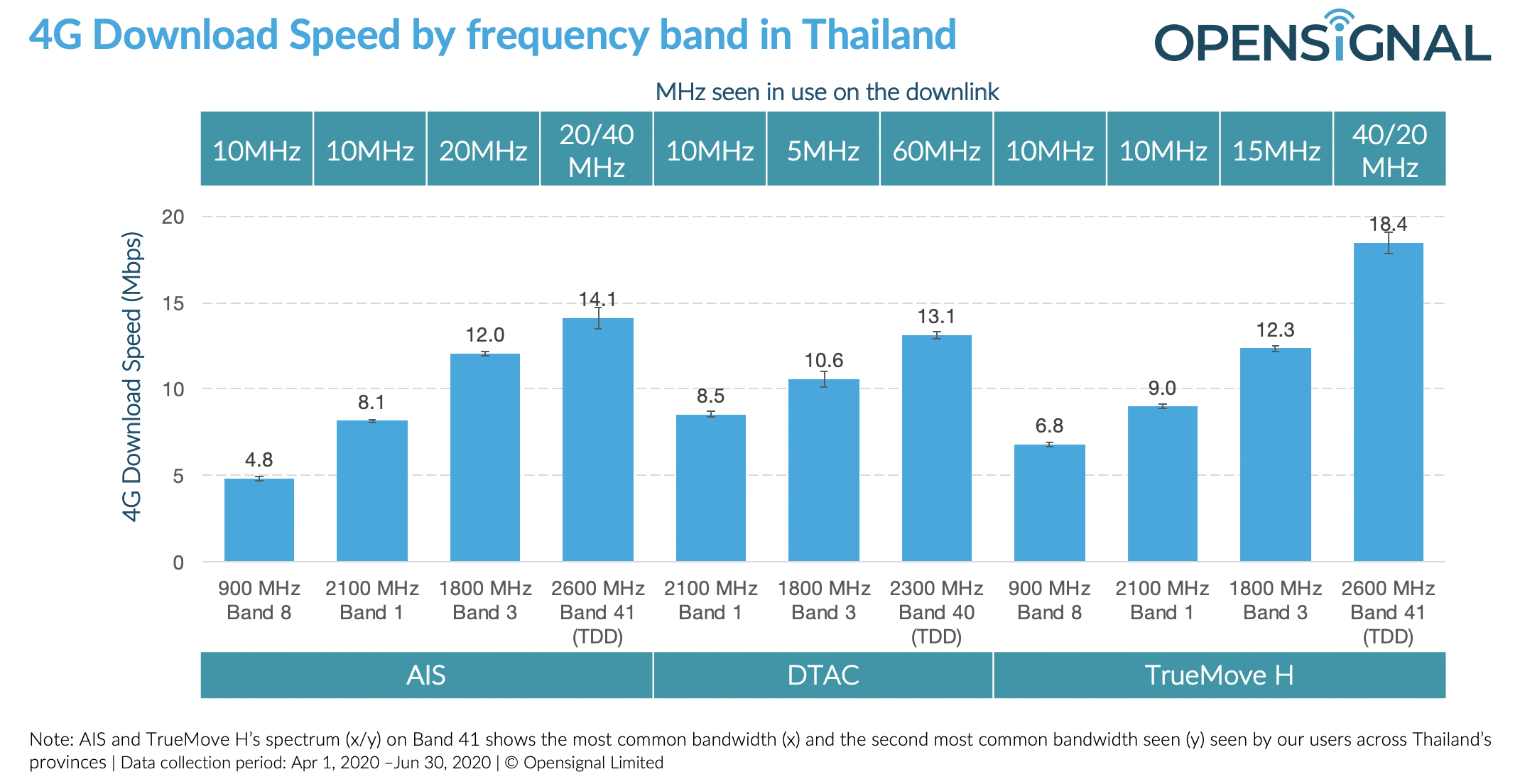ประเทศไทย, 10 สิงหาคม 2563 – Opensignal ผู้ดำเนินการวิเคราะห์ระบบมือถือและกำหนดมาตรฐานระดับโลกเผยการวิเคราะห์ภาพรวมตำแหน่งคลื่นความถี่ของผู้ให้บริการโทรศัพท์มือถือทั้งสามรายในประเทศไทย ได้แก่ DTAC AIS และ TrueMove H ช่วงก่อนและหลังการประมูลคลื่น 5G เพื่อทำความเข้าใจถึงการนำคลื่นความถี่ใหม่มาปรับใช้จะส่งผลต่อประสบการณ์เครือข่ายมือถือในประเทศไทยอย่างไร เพราะคลื่นความถี่ถือว่ามีอิทธิพลอย่างมากต่อคุณภาพของประสบการณ์เครือข่ายมือถือ
ตามที่ กสทช. (คณะกรรมการกิจการกระจายเสียง กิจการโทรทัศน์ และกิจการโทรคมนาคมแห่งชาติ) ได้จัดงานประมูลคลื่น 5G ขึ้นเมื่อ 16 กุมภาพันธ์ที่ผ่านมา เพื่อปูทางไปสู่การเปิดใช้ 5G โดยในการประมูลนั้น AIS ได้คลื่นความถี่แบนด์ 41 (TDD, 2600 MHz) รวม 100 MHz (10 ใบอนุญาต) และ TrueMove H ได้รวม 90 MHz (9 ใบอนุญาต) Opensignal พบว่าระหว่างวันที่ 1 เมษายนถึง 30 มิถุนายน ที่ผ่านมา ทั้ง AIS และ TrueMove H ได้ใช้คลื่น 2600 MHz ที่ได้มาใหม่นี้ 20-40 MHz สำหรับ 4G โดยขึ้นอยู่กับพื้นที่
การนำคลื่นความถี่ 2600 MHz มาใช้งานส่งผลต่อความเร็วการดาวน์โหลด 4G อย่างไร?
เพื่อแสดงให้เห็นถึงผลกระทบของการนำคลื่นความถี่ 2600 MHz มาใช้ เราได้วิเคราะห์ประสบการณ์ความเร็วดาวน์โหลดจากผู้ใช้งานของเราบนเครือข่าย 4G ที่แตกต่างกันในประเทศไทย พบว่าผู้ใช้คลื่นความถี่ Band 41 ได้รับประสบการณ์ความเร็วในการดาวน์โหลด 4G ดีกว่าอย่างเห็นได้ชัดทั้งบนเครือข่ายของ AIS และ TrueMove H มีความเร็วดาวน์โหลดเฉลี่ยที่ 14.1 Mbps และ 18.4 Mbps ตามลำดับ โดยผู้ใช้ที่เชื่อมต่อบนคลื่นความถี่สูงกว่ามักจะได้รับประสบการณ์การใช้งานที่รวดเร็วกว่าผู้ใช้ในย่านความถี่ต่ำเนื่องจากมีแบนด์วิดท์มากกว่า

AIS และ TrueMove H กำลังปรับใช้แบนด์วิดท์ 4G มากกว่า DTAC
เราประเมินการถือครองคลื่นความถี่ของผู้ให้บริการโทรศัพท์มือถือแต่ละรายและพบว่าก่อนการประมูลคลื่นความถี่เมื่อเดือนกุมภาพันธ์นั้น DTAC ใช้คลื่นความถี่สูงสุด (90 MHz) สำหรับบริการ 4G ตามด้วย AIS (80 MHz) และ TrueMove H (70 MHz) ตามลำดับ อย่างไรก็ตามหลังการประมูลสิ้นสุด AIS และ TrueMove H นำคลื่นความถี่ Band 41 ใหม่ไปใช้ใน 4G เพิ่มเติมระหว่าง 20 ถึง 40MHz (ปริมาณขึ้นอยู่กับพื้นที่) ทำให้ปริมาณการใช้คลื่น 4G สูงขึ้นเป็น 120 MHz และ 110 MHz ตามลำดับ แต่คลื่น 4G ของ DTAC ไม่มีการเปลี่ยนแปลงใด ๆ

จากการตรวจสอบเพิ่มเติม Opensignal พบว่าผู้ให้บริการโทรศัพท์มือถือนำคลื่นความถี่ใหม่ไปใช้ในบางพื้นที่เท่านั้น: ซึ่ง AIS นำคลื่นความถี่ 40 MHz ไปใช้เฉพาะในจังหวัดที่มีประชากรหนาแน่น เช่น กรุงเทพมหานคร และใช้คลื่นความถี่ 20 MHz ในพื้นที่ที่เหลือ ในขณะที่การใช้งานคลื่น 40 MHz ของ TrueMove H มีขอบเขตที่กว้างกว่า
อย่างไรก็ตาม ผลกระทบในระยะยาวต่อประสบการณ์ใช้งานอุปกรณ์เคลื่อนที่นั้นยังไม่มีความชัดเจนเนื่องจากทุกอย่างเพิ่งเริ่มต้นและขึ้นอยู่กับจำนวนผู้ใช้ รวมถึงปริมาณการใช้ข้อมูลทั้งหมด แต่หากในอนาคตเมื่อคลื่น Band 41 มีการนำมาใช้งานอย่างแพร่หลายมากขึ้น ประสบการณ์การใช้งานอุปกรณ์เคลื่อนที่ของผู้ใช้ย่อมดียิ่งขึ้น หากการใช้งานนั้นไม่ได้ล้ำหน้าการใช้งานบนคลื่นความถี่ที่ปรับใช้เพิ่มเติมโดยผู้ให้บริการโทรศัพท์มือถือ
5G ดึงศักยภาพการใช้คลื่นความถี่ประสิทธิภาพสูงที่จะช่วยลดความแออัด
นี่เป็นเพียงจุดเริ่มต้นของยุค 5G ในประเทศไทย ดังนั้นจึงเร็วเกินไปที่จะสรุปอนาคตของ 5G อย่างไรก็ตามการใช้งานเครือข่ายอย่างหนักหน่วงยังเป็นปัจจัยสำคัญที่ทำให้ความเร็วในการดาวน์โหลดต่ำ เนื่องจากคลื่นความถี่เป็นทรัพยากรที่มีจำกัด ผู้ให้บริการโทรศัพท์มือถือไทยจึงจำเป็นต้องสร้างสมดุลการใช้ทรัพยากรนี้ระหว่างผู้ใช้ 5G ใหม่และผู้ใช้ 4G ที่เป็นกลุ่มผู้ใช้ส่วนใหญ่ในปัจจุบันโดยเฉพาะอย่างยิ่งเมื่อมีการใช้อุปกรณ์ 5G มากขึ้น
เทคโนโลยี 5G ช่วยให้สามารถเข้าถึงคลื่นความถี่ใหม่สมรรถนะสูงที่สามารถบรรเทาความแออัดของการใช้งานเครือข่ายได้ ตัวอย่างเช่นผู้ให้บริการโทรศัพท์มือถือในประเทศไทยยังได้รับคลื่นความถี่แบบ mmWave ในย่านความถี่ 26 GHz ซึ่งมีสมรรถนะและความเร็วสูงมาก แต่ครอบคลุมพื้นที่ไม่กว้างซึ่งทำให้เหมาะสำหรับย่านใจกลางเมืองที่มีประชากรหนาแน่นมาก แต่ไม่เหมาะกับการนำไปกระจายใช้งานในพื้นที่กว้างขวาง หมายความว่าผู้ใช้ 5G ในประเทศไทยส่วนใหญ่มักจะใช้คลื่นความถี่ระดับกลางเช่นคลื่นความถี่ 2600 MHz เพื่อเชื่อมต่อกับ 5G แทนที่จะเป็น mmWave
เกี่ยวกับ Opensignal
Opensignal เป็นบริษัทผู้ดำเนินการวิเคราะห์ระบบมือถือและกำหนดมาตรฐานระดับโลกโดยอิสระเพื่อทำความเข้าใจสถานะที่แท้จริงของเครือข่ายมือถือโลกโดยอิงจากการวัดประสบการณ์ผู้ใช้จริง รายงานอุตสาหกรรมของบริษัท สามารถใช้เป็นแนวทางที่ชัดเจนเพื่อเข้าใจประสบการณ์จริงที่ผู้บริโภคได้รับจากเครือข่ายไร้สาย และเราทำการวัดนี้กับผู้ให้บริการเครือข่ายรายใหญ่ทุกรายทั่วโลก
Thailand August 10, 2020 – Opensignal analyzed the spectrum position of Thailand’s three national operators — DTAC, AIS and TrueMove H — before and after the auction of the 5G spectrum to understand how the deployment of this new spectrum will affect mobile network experience in the country, as spectrum greatly influences the quality of mobile network experience.
Thailand’s National Broadcasting and Telecommunications Commission (NBTC) held the auction of new spectrum bands suited for 5G on February 16, paving the way for its 5G rollouts. During that auction AIS acquired 100 MHz of spectrum and TrueMove H acquired 90 MHz of spectrum on Band 41 (TDD, 2600Mhz). We found that after the auction, between April 1 and June 30, AIS and TrueMove H have utilized 20-40 MHz of this new 2600 MHz band for 4G, depending on the location.
How has the deployment of the 2600 MHz band affected 4G download speeds?
To understand the effect of the newly deployed spectrum on mobile network experience, we analyzed the download speeds experienced by our users on different 4G bands in Thailand and discovered that the 4G Download Speed Experience of our users on Band 41 was significantly better than that on the pre-existing bands for both AIS and TrueMove H. Our users, on average, saw 4G download speeds of 14.1 Mbps on AIS and 18.4 Mbps on TrueMove H when using Band 41. This is because users connecting on higher frequency spectrum typically enjoy higher speeds than those on lower frequency bands, due to the larger amounts of bandwidth available.

AIS and TrueMove H are now deploying more 4G bandwidth than DTAC
We assessed the spectrum holdings of each of these operators and found that before the February spectrum auction, DTAC was using the largest amount of spectrum (90MHz) for 4G services followed by AIS (80 MHz) and TrueMove H (70 MHz). However, after the auction, AIS and TrueMove H started using an additional 20 to 40 MHz in Band 41 (the amount depends on the area) for 4G and their total 4G spectrum usage grew to 120 and 110 MHz respectively, while DTAC’s 4G spectrum position remained unchanged.

On further examination we found that operators deployed new spectrum to some areas but not others: AIS has deployed 40 MHz only in a few densely populated provinces such as Bangkok and 20 MHz in the remaining areas, while TrueMove H’s use of 40 MHz was more widespread.
However, the long-term magnitude of the impact on mobile experience due to these new deployments is still unclear and depends on the number of users and their total data consumption. In the future, as Band 41 becomes more widely deployed the mobile experience should improve, provided rising mobile usage does not outpace the additional spectrum deployed by operators.
5G enables the use of high capacity spectrum which will help reduce congestion
It’s still just the beginning of the 5G era in Thailand, so it’s early to draw conclusions on the future of 5G. However, heavy network usage remains a big factor keeping download speeds low. As spectrum is a scarce resource, Thai operators will need to balance their resources between the new 5G users and the majority of existing 4G users, especially when 5G device-adoption takes off.
However, 5G technology enables access to new high capacity spectrum bands which can help to relieve congestion. For example, operators in Thailand have also acquired mmWave spectrum in the 26 GHz band which will provide high capacity and superfast speeds but exhibit relatively lower coverage. This makes it suitable for very densely populated city centres but not for widespread deployment. This implies that the majority of Thailand’s 5G users will likely rely on mid-band spectrum such as 2600 MHz spectrum to connect to 5G rather than mmWave.
About Opensignal
Opensignal is a mobile analytics company. It’s the independent global standard for understanding the true state of the world’s mobile networks based on measurements of real user experience. Opensignal’s industry reports are the definitive guide to the true experience consumers receive on wireless networks, and it independently measure this across every major network operator around the globe.


